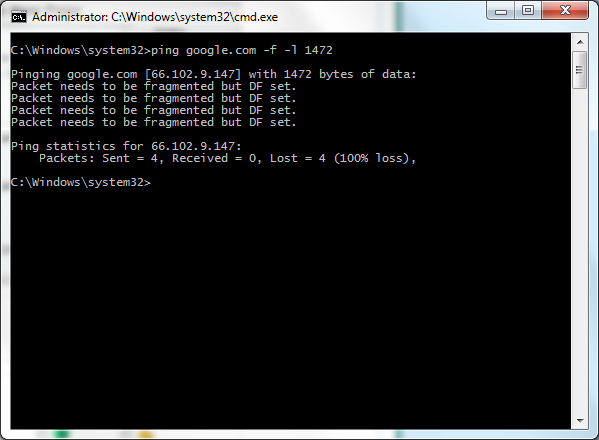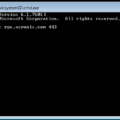If you’re looking to get the most out of your network, testing the Maximum Transmission Unit (MTU) is an important step. The MTU is the maximum size of a packet that can be sent across a network. If it’s too small, the data packets will become fragmented, causing delays and potentially leading to data corruption. On the other hand, if it’s too large, packets may not be routed correctly and could result in dropped connections or reduced performance.
Fortunately, testing for optimal MTU size is relatively simple and can help you ensure that your network is running at its best. To begin, you’ll need to determine what type of network interface you’re using. For example, if you’re using an Ethernet connection, or are connected to a PPPoE DSL network, then the optimal MTU size would be 1492.
Once you’ve determined your type of connection, you can perform a DOS Ping Test to find the optimal size for your MTU. This test involves sending ping requests with progressively lower packet sizes until they no longer need to be fragmented. In Windows systems, this can easily be done by opening up a command prompt window and typing “ping www.yahoo.com -f -l 1492”. The results should indicate whether or not it needs to be fragmented; if so then it’s recommended that you reduce the packet size slightly until fragmentation is no longer necessary.
The final step in testing for optimal MTU size is adjusting the subinterface on your router accordingly. This is done by typing “netsh interface ipv4 set subinterface `Local Area Connection` mtu=1472 store=persistent” into a command prompt window on Windows systems (replacing 1472 with whatever value your ping test indicated). After that you should check the result by typing “netsh interface ipv4 show subinterface” into the command prompt window; this will let you know if it was successful or not.
By properly testing and adjusting your MTU settings according to what works best for your system and connection type, you can ensure that your network runs as quickly as possible without any data loss or corruption due to fragmentation errors.
Testing Your Maximum Transmission Unit (MTU)
Testing your Maximum Transmission Unit (MTU) size is an important step to ensure that your computer is able to communicate efficiently with other computers on the network. To test your MTU size, you will need to use the Windows Command Prompt application.
First, open the Command Prompt window. In Windows 10, search for ‘command prompt’ in the start menu and open it. In earlier versions of Windows, go to Start and select Run. Type in cmd (for Windows 2000/XP) or command (for Windows 98/ME) into the Open: field.
Once you have opened the Command Prompt window, type in ping www.yahoo.com -f -l 1492 and hit Enter. This command will send a packet of data with a length of 1492 bytes – which is one byte less than the maximum packet size of 1500 bytes – to Yahoo’s server and measure how long it takes for it to arrive there and back again. If the packet arrives without being fragmented, then your MTU size is 1492 bytes or lower; if it needs to be fragmented, then your MTU size is higher than 1492 bytes.
To find out the exact amount of your MTU size, you’ll need to repeat the above steps with increasing packet sizes until you reach a packet that does not need fragmentation; this number will be your MTU size. For example, if a packet with a length of 1496 bytes needs to be fragmented but one with a length of 1500 bytes does not, then your MTU size is 1500 bytes.

Verifying MTU Functionality
The best way to know that your MTU is working is to test it. You can do this by sending out a series of ping requests and progressively lowering the packet size until the packet no longer needs to be fragmented. When you reach this point, it means that your MTU is set correctly and is able to handle the data you’re sending. If the packets have to be fragmented, then it means that your MTU is too low and needs to be increased. Once you find the correct settings, you can be sure that your data will be sent without any fragmentation.
Testing MTU on Windows 10
To test your MTU settings in Windows 10, you will need to use the Command Prompt. First, open the Command Prompt with administrator privileges by typing “cmd” in the search bar, right-clicking on it, and selecting “Run as Administrator”. Once the Command Prompt is open, type “netsh interface ipv4 show subinterface” and press Enter. You will see a list of network interfaces. Then type “netsh interface ipv4 set subinterface `Local Area Connection` mtu=1472 store=persistent” and press Enter. This will set your MTU to 1472 bytes. To check if your changes were successful, type “netsh interface ipv4 show subinterface” again and check that the MTU is set to 1472 bytes. Finally, you can run an online MTU test using a website like Speedtest or other similar tools to confirm that your settings are working correctly.

What is the Ideal MTU Size?
The ideal MTU size is the size that optimizes the performance of your network. It should be large enough to accommodate the largest packet size transmitted by any device on your network without fragmenting, but not so large that it causes unnecessary overhead. In general, for WAN interfaces connected to a PPPoE DSL network, an MTU of 1452 is the most optimal. This is slightly smaller than the maximum allowed MTU (1492) which is typically discovered using auto MTU discovery. An MTU of 1452 provides just enough space for larger packets while reducing unnecessary overhead.
Can MTU Be Higher Than 1500?
Yes, your MTU can be higher than 1,500 bytes. These are known as jumbo frames and are typically used with fast Ethernet links, such as a gigabit LAN. The maximum size of a jumbo frame can be up to 9,000 bytes. Using larger packets reduces the overhead and increases the efficiency of data transmission.

Source: networkworld.com
The Benefits of a 1500 MTU Setting
Yes, 1500 MTU is a good setting for most networks. This is the default setting of most networking equipment and can be used to maximize performance and efficiency when communicating with other devices on the same network or over the internet. It is important to note that certain applications may require a lower MTU in order to function properly, so if you experience any issues with your connection, it may be worth exploring this option further.
Troubleshooting MTU Mismatch
To troubleshoot the MTU mismatch, you need to take a look at both the client and the server side. On the server side, you should check the router settings to see if it is set to a 1500 bytes MTU size. If so, try hardcoding it to a smaller size. On the client side, you should use DHCP option 26 to set the clients to a smaller MTU size as well or hardcode them with a smaller size if necessary. Additionally, make sure your routers do not drop ICMP “Destination Unreachable-Fragmentation Needed and DF Set” messages. Once you have checked both sides for any potential mismatches in MTU sizes and adjusted them accordingly, test your network again to ensure that the issue has been resolved.
Does Increasing MTU Improve Internet Speed?
Adjusting your router’s MTU setting can potentially increase your Internet speed, but it is not a guarantee. The primary purpose of the MTU setting is to ensure that packets sent across a network are not too large for the network to handle. If the packets are too large, they will have to be split into smaller chunks, which will take more time and can slow down the transmission. By changing the MTU setting to an appropriate size, you can help minimize packet fragmentation, which in turn can result in faster transmission times. However, it is important to remember that other factors such as server load and your own connection speed also play a role in determining how fast your Internet connection will be.
Optimal MTU Settings for Gaming
A good MTU for gaming is typically 1400-1500 bytes. This will ensure that your gaming experience is as efficient and smooth as possible. You should test different values to find the best MTU for your specific system, but this range should be a good starting point. Remember that if you set the MTU too high, you may experience packet loss or lag issues. If you set it too low, then your connection could become congested or unreliable.
Consequences of Having an MTU That Is Too Small
If the MTU size is set too small, it can cause issues with applications that need to transfer large amounts of data. For example, applications like streaming video may not be able to send large video files if the MTU is too small, resulting in slow performance or frequent buffering. Additionally, some routers will ignore packet-too-big messages and keep sending packets that exceed the MTU, causing further performance degradation. This can lead to packet fragmentation which can reduce network performance and increase latency.
What is the Optimal MTU Setting?
The answer to this question depends on what type of network you are using. Generally, a default MTU size of 1500 is recommended for most networks, including broadband Internet. This is because a larger MTU size will provide more efficient data transmission, while a smaller MTU size could lead to decreased performance. If you are using a PPPoE connection or an IPSec (Secure VPN), then a smaller MTU size of 576 may be necessary in order to ensure that these connections work properly. Otherwise, it is best to use the default MTU size of 1500.
Maximum MTU Size for Ethernet
The maximum MTU size for Ethernet depends on the type of Ethernet implementation being used. Standard Ethernet supports an MTU of 1500 bytes, while Ethernet implementations that support jumbo frames allow for an MTU of up to 9000 bytes. The higher MTU size of jumbo frames is beneficial as it allows larger amounts of data to be sent in a single packet, reducing the number of packets sent and the required network overhead.
Conclusion
In conclusion, testing MTU is an important step in configuring your network to ensure optimal performance. It involves sending out and progressively lowering ping requests until the packet no longer needs to be fragmented. The recommended MTU for WAN interfaces connected to a PPPoE DSL network is 1492, but having an MTU of 1472 is optimal as it will ensure higher speeds and fewer lost packets. This process should be repeated periodically in order to guarantee the best performance from your network.








